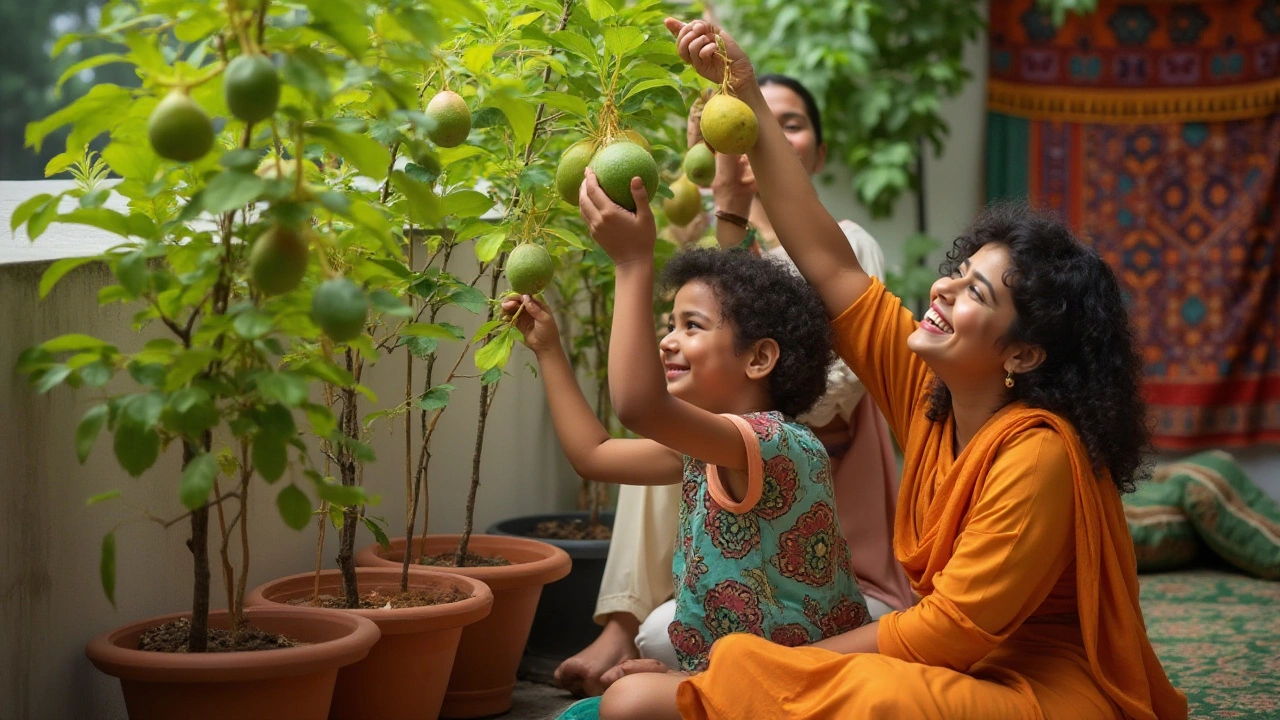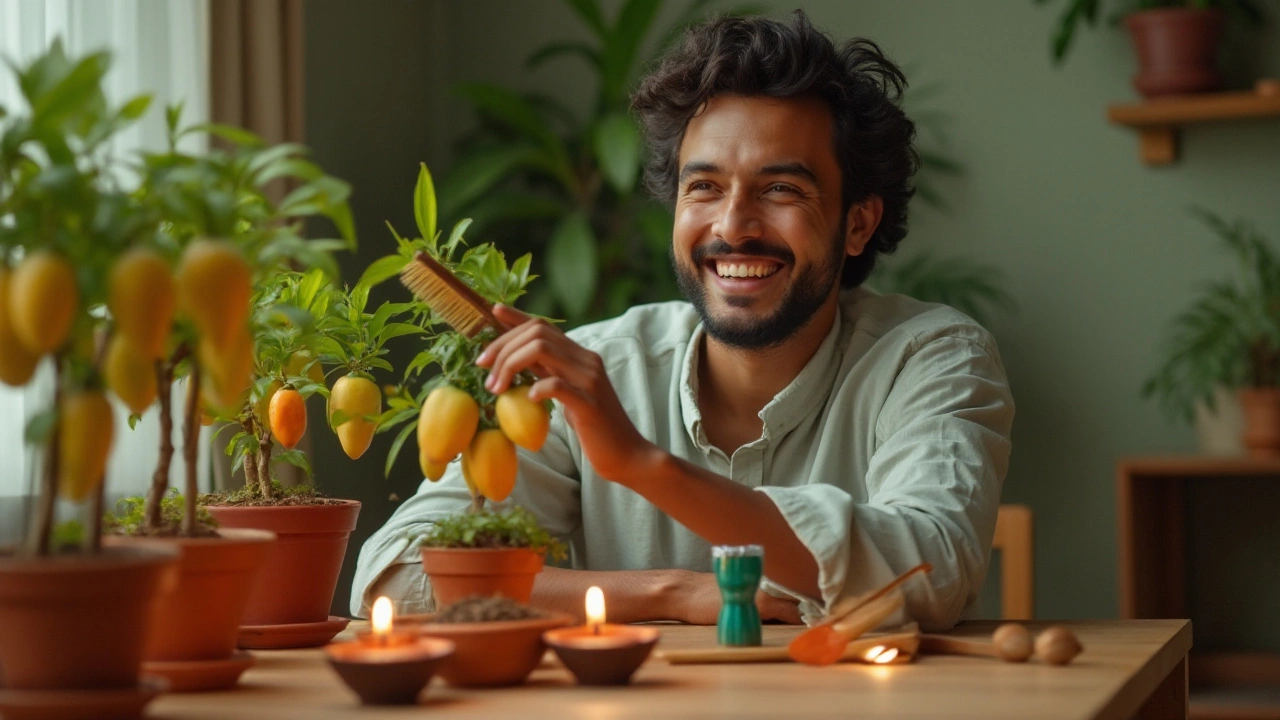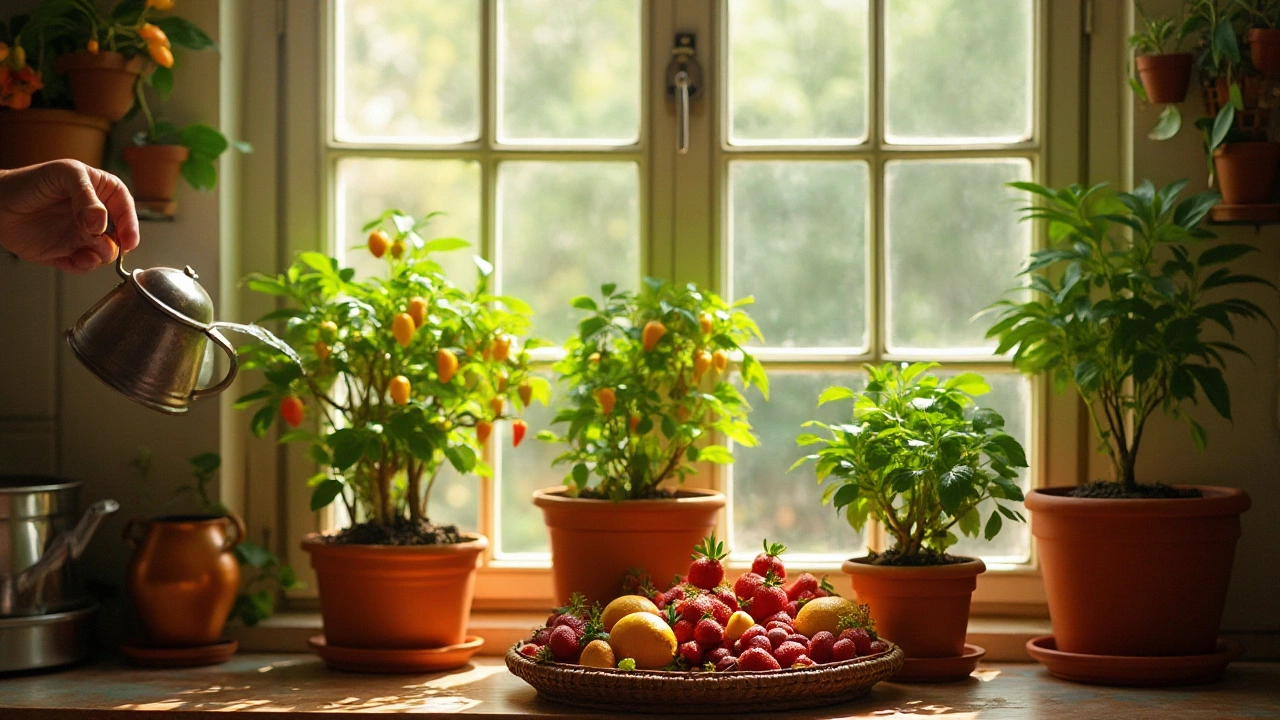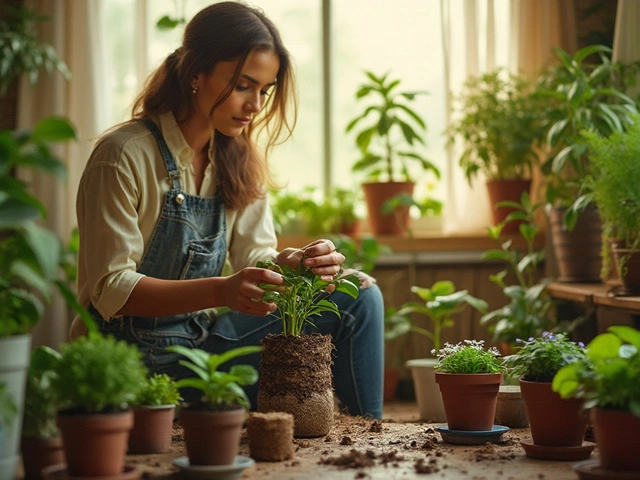Embracing the world of indoor gardening is both charming and practical. Imagine stepping into your kitchen and finding a small oasis where fruits grow right by the window. Growing fruit indoors is not only about nurturing plants; it's about adding a splash of greenery and a taste of fresh produce to your life.
Whether you lack outdoor space or simply wish to bring nature inside, starting with easy-to-grow indoor fruits is a wonderful way to begin. These resilient fruits can thrive indoors with minimal effort, allowing even the busiest of individuals the chance to enjoy gardening pleasures. Let's explore how you can turn your living space into a fruitful garden.
- Why Grow Fruit Indoors?
- Top Easy-to-Grow Indoor Fruits
- Tips for Indoor Fruit Garden Success
- Common Challenges and Solutions
Why Grow Fruit Indoors?
Growing fruits indoors is an intriguing affair for many who seek both the aesthetic and functional benefits of indoor gardens. Not only does it allow for a sense of accomplishment and care within the confines of your home, but it brings the subtle beauty of nature into your daily life. Imagine the delightful aroma of fresh citrus or the vibrant hue of strawberries growing just a few steps from where you cook. The convenience of having fresh produce readily available is an inviting aspect of cultivating fruits indoors, especially as urban living restricts access to expansive gardens.
Indoor fruit plants contribute positively to mental wellness by offering a serene escape from the hustle and bustle. The joy of nurturing life and witnessing the transformation from tiny buds to ripe fruits can induce a sense of peace and fulfillment. Not to mention, these plants improve air quality by absorbing carbon dioxide and releasing oxygen. NASA's Clean Air Study notes that plants can remove toxins such as formaldehyde and benzene, making your indoor environment healthier.
Year-Round Harvests
One significant advantage is the opportunity for year-round harvests. When you control the temperature and lighting conditions, you can mimic the ideal growing situation for your plants regardless of the season outside. Hence, fruits like lemons and limes, which would not typically thrive in colder climates, can flourish indoors. The satisfaction of plucking a ripe lemon for your tea or lemon pie in the dead of winter cannot be overstated, providing a culinary delight that is both fresh and homegrown.
"The best time to plant a tree was 20 years ago. The second best time is now." - Chinese Proverb
Saving Money and Promoting Sustainability
Beyond the personal benefits, growing fruit indoors can also offer financial savings. As the prices of fresh fruits rise seasonally, having your own supply reduces the need for store-bought alternatives. Moreover, by growing your own, you minimize the carbon footprint associated with transporting fruit from farms to supermarkets. This step not only reduces waste but promotes a sustainable lifestyle where you can control pesticide use, ensuring that your fruits are organic and healthy.
Finally, cultivating fruits indoors can be a wonderful educational experience. Children, especially, can learn about life cycles, botany, and the importance of nurturing the environment right at home. This hands-on approach instills an awareness and respect for the natural world, creating an indelible impact that encourages greener choices throughout life.

Top Easy-to-Grow Indoor Fruits
When it comes to the realm of indoor gardening, some fruits are simply easier to manage than others. Starting with these makes the experience more enjoyable, rewards you sooner, and builds confidence as you nurture your indoor oasis. Many people are surprised to find that certain fruits adapt well to living rooms or kitchens, thriving in pots with adequate sunlight and care. Among the champions of the indoor fruit world are citrus fruits, strawberries, and figs, each bringing a unique flavor and aroma that can freshen any space.
Citrus Fruits
Small citrus trees, such as lemons, limes, and oranges, are beloved for their aesthetics and productivity. Not only do they provide a lush, green ambiance, but they also grace your home with zesty eruptions of flavor. These trees are particularly well-suited to indoor life when they have a sunny spot to call home. They thrive in bright, indirect light and rich, well-draining soil. Remember, citrus plants are sensitive to overwatering, so it's wise to water only when the topsoil is dry.
One of the beauties of growing citrus indoors is the year-round possibility of blooms and fruits, which depend on your care and local environment. Dwarf varieties like Calamondin or Meyer Lemon are popular choices due to their space-saving nature and full-sized fruit production. According to an article in Gardening Monthly, "Growing citrus indoors not only provides a decorative benefit but also offers a continuous supply of vitamins and fresh scents."
Strawberries
Strawberries are another favorite when it comes to indoor gardening. These delightful berries are not only delicious but also visually appealing, providing vibrant splashes of red against lush green leaves. Strawberries adapt well to container life, needing direct sunlight to produce sweet, juicy fruit. They perform well in hanging baskets or pots where their generous runners can cascade down in a charming, decorative splash.
For those with limited light, using a grow light can supplement the sun's rays and encourage more abundant fruiting. Strawberries love humidity, so a regular misting or placing a humidity tray nearby can improve their growth conditions. In a controlled indoor setting, pests are less likely to bother them, making maintenance straightforward and manageable.
Figs
For anyone seeking a fruit that grows well indoors, figs stand out as a resilient option. These plants can thrive in an indoor environment with bright light and moderate care. Figs do wonderfully in containers, making them suitable for urban apartments or homes with limited outdoor space. With a minimalistic yet bold aesthetic, fig trees make a stylish addition to any decor.
They prefer to dry out a little between waterings, so letting the soil go dry to an inch deep is ideal before watering again. Figs also enjoy being root-bound, so they won’t mind a cozy pot—just ensure their pot has good drainage. A fig tree can produce fruit twice a year under the right conditions, enhancing both the visual and nutritional aspects of your home garden.
"Growing your own figs indoors offers not only a charming addition to interior spaces but also a naturally sweet harvest that's hard to beat," shares Helena Green, a notable horticulturist from the Urban Botanical Collective.
For anyone committed to the idea of growing fruit indoors, beginning with these varieties offers promising yields and a lush experience. As you expand your gardening skills, these fruits can serve as stepping stones to a fuller indoor horticultural journey.

Tips for Indoor Fruit Garden Success
When you're ready to embark on the journey of indoor gardening, there are several considerations to keep in mind to ensure your plants thrive and produce delicious fruit. To achieve success, the key lies in replicating the conditions fruits enjoy in their natural environments, while taking advantage of the unique aspects of indoor settings. Light, water, soil, and care are at the heart of prospering fruit plants, and understanding how to manage these elements is crucial. Let's dive into these with some detailed insights.
The significance of light cannot be understated in indoor fruit gardening. Most fruit plants require ample sunlight to grow healthily and produce fruit. If your home lacks natural sunlight, consider investing in LED grow lights, which can simulate natural light conditions. It’s often best to place fruiting plants near south or west-facing windows as these spots generally receive the most sunlight during the day. Remember, moving plants closer to direct light and rotating them regularly can help ensure they receive equal light exposure on all sides. As Mark Cullen, a respected Canadian gardening expert, once mentioned,
"While artificial light can't completely replace the sun, it can keep plants flourishing when days darken."
Watering practices are just as pivotal. Overwatering is a leading cause of plant distress, which is often as damaging as underwatering. Monitoring your plant's soil moisture is a practical approach to determine if your plants need watering. Use your fingers to gauge; if the top inch of soil feels dry, it's likely time to water. Depending on the plant's species, consistent moisture without oversaturation is ideal. To prevent root rot, ensure your pots have drainage holes and that you don't allow water to pool at the pot's base. Remember, during winter months, indoor-grown fruits may need less water due to diminished ambient evaporation rates.
Certain basics of soil preparation and nutrition can make a significant difference. When it comes to indoor gardening, using high-quality potting soil is non-negotiable. It provides the nutrients and drainage essential for healthy fruit plant growth. Mixing perlite or vermiculite with the soil can further improve its structure and drainage capabilities. Moreover, feeding plants with an appropriate fertilizer tailored to fruiting plants will encourage vigorous growth. Experts often recommend organic fertilizers for a more balanced nutrient supply, promoting both plant and soil health.
Temperature and humidity also play a pivotal role. Most fruits thrive in temperatures ranging from 65°F to 75°F. Keep your fruit plants away from drafts, excessive heat sources, or drastic fluctuations. Using a humidifier in dry environments can help maintain the appropriate humidity levels, as indoor air often becomes drier, especially in winter. Be vigilant for signs like leaf browning or wilt, which can indicate stress from unsuitable humidity levels.
Finally, commitment and observation are vital components. Regularly check your plants for signs of pests or diseases. It's easier to address problems when caught early, preventing them from spreading further. Pruning is also essential; remove dead or yellowing leaves to foster new growth and ensure the plant's energy focuses on producing fruit. Consistent observation will not only build your knowledge over time but also strengthen your connection with your garden, adding more delight and satisfaction to your indoor fruit gardening experience.

Common Challenges and Solutions
Delving into indoor gardening comes with its set of challenges, especially when growing fruits indoors. One of the most prevalent issues is ensuring adequate light. Many fruiting plants require ample sunlight to produce healthy fruit, yet indoor conditions often limit exposure. Utilizing grow lights can bridge this gap. Placing lights 6-12 inches above plants mimics the sun’s rays, thus encouraging growth. Rotate the plants regularly so each side gets equal exposure. Modern LED lights use less electricity, providing a sustainable way to meet your indoor garden’s needs, thus making fruit growth indoors feasible for busy lifestyles.
Another hurdle is maintaining optimal temperature and humidity; two factors usually beyond control inside homes. Most fruits thrive in temperatures between 65-75°F, with citrus fruits preferring the cooler sides and tropical species needing warmth. Drafts from windows or HVAC systems can disrupt this balance, stunting growth or fruit production. To circumvent such issues, consider utilizing humidity trays or small humidifiers especially during dry winter months. An effectively managed temperature and humidity level can make or break an indoor fruit garden's success, bringing the green thumb experience to any dwelling.
"Indoor gardens transform spaces into vibrant ecosystems, adding life to an otherwise sterile environment," remarked renowned botanist, Dr. Lillian Turner. Indeed, the psychological benefits associated with gardening are just as vital as the physical outcomes. The joy of seeing a small miracle unfold, like a citrus tree bearing fruit, often counts as its own reward.
Pest control represents another significant challenge. Indoor fruits are not immune to aphids, spider mites, or whiteflies which thrive in confined spaces. To mitigate these pest issues naturally, employ a mixture of dish soap and water spray weekly. This simple remedy prevents infestations without harmful chemicals. Ladybugs or other beneficial insects can be introduced to indoor gardens as natural predators. Select solutions that align with eco-friendly values and protect your healthy indoor environment.
Nutrient management is crucial for sustainable fruit production. Indoor plants rely entirely on provided soil, which can become depleted. Employing a balanced water-soluble fertilizer every 4-6 weeks gives your plants the nutrition they require for effective growth. Monitoring your plant's growth will indicate any nutrient deficiencies, which can be remedied through specific fertilizers. Organic options encourage a sustainable approach without adding harmful chemicals to your home.
Should You Get Creative?
For addressing easy fruit plants growth challenges creatively, utilizing vertical spaces with hanging pots or tiered shelving extends the possibilities. If space is limited horizontally, using vertical expansion enriches the indoor garden layout, offering more room for light and airflow. Pot size also dramatically impacts plant health, with larger pots often supporting larger root systems, crucial for prolific fruit growth.
| Common Problem | Solution |
|---|---|
| Light Deficiency | Use LED Grow Lights |
| Low Humidity | Employ Humidity Trays |
| Pest Infestation | Spray with Soap and Water |
| Soil Nutrient Depletion | Apply Balanced Fertilizer |
Each of these potential issues represents a stepping stone to perfecting indoor fruit growth. By investing time in understanding and mitigating these challenges, you join a longstanding tradition of indoor cultivation that keeps you connected to nature, one fruit at a time.





